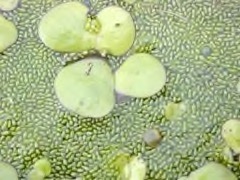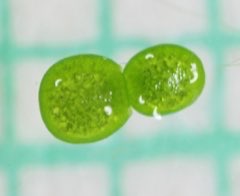 |
|
wikimedia.org |
 |
| Andrey Zharkikh from Salt Lake City, USA wikimedia.org |
Translate this page:
Summary
Wolffia globosa, commonly known as Khai Nam or Water-Eggs, is a very small aquatic herb with free floating fronds. It is a tropical and subtropical plant and one of the smallest flowering plants worldwide. It is a cultivated vegetable crop in Laos, Burma, and Thailand. The edible leaves have an excellent flavor and are very nutritious. No plant part is of medicinal use.
Physical Characteristics
![]()
![]() Wolffia globosa is an evergreen Perennial at a fast rate.
Wolffia globosa is an evergreen Perennial at a fast rate.
See above for USDA hardiness. It is hardy to UK zone 10. The plant is self-fertile.
It is noted for attracting wildlife.
It cannot grow in the shade. It prefers wet soil and can grow in water.
UK Hardiness Map
US Hardiness Map
Synonyms
Plant Habitats
Edible Uses
Edible Parts: Leaves
Edible Uses:
Leaves - cooked. An excellent flavour, they taste somewhat like a sweet cabbage[183 ]. The leaves are very nutritious, containing about 20% protein, 44% carbohydrate. 5% fat and are rich in vitamins A, B2, B6, C and nicotinic acid[183 ].
References More on Edible Uses
Medicinal Uses
Plants For A Future can not take any responsibility for any adverse effects from the use of plants. Always seek advice from a professional before using a plant medicinally.
Vitamin C
None known
References More on Medicinal Uses
The Bookshop: Edible Plant Books
Our Latest books on Perennial Plants For Food Forests and Permaculture Gardens in paperback or digital formats.

Edible Tropical Plants
Food Forest Plants for Hotter Conditions: 250+ Plants For Tropical Food Forests & Permaculture Gardens.
More

Edible Temperate Plants
Plants for Your Food Forest: 500 Plants for Temperate Food Forests & Permaculture Gardens.
More

More Books
PFAF have eight books available in paperback and digital formats. Browse the shop for more information.
Shop Now
Other Uses
Agroforestry uses:
Wolffia globosa is often used in aquaculture systems as a high-protein food source for fish and other aquatic animals. It can also help improve water quality by absorbing excess nutrients.
1. Nectary - Flowers rich in nectar and pollen:
No – Wolffia globosa is a tiny aquatic plant known for its small size and lack of prominent flowers. It doesn’t produce significant nectar or pollen.
2. Wildlife - Food (Fruit, Seeds, Leaf litter, Shelter, Nesting, Roosting):
Yes – Wolffia globosa is edible and is consumed in various cultures. It provides a food source for aquatic organisms, and while it does not offer traditional shelter, it can contribute to habitat structure in aquatic environments.
3. Invertebrate Shelter (Overwintering sites, Leaf litter, Groundcover):
Yes – It can provide some habitat for small aquatic invertebrates, serving as a substrate in water bodies where they can find shelter.
4. Pest Confuser (Smell):
No – Wolffia globosa is not known for any pest-confusing properties or aromatic compounds that deter pests.
Special Uses
Food Forest
References More on Other Uses
Cultivation details
A pond plant, it requires a sunny position in still water that is rich in nitrates and lime[200 ]. It over-winters in temperate areas by means of resting buds which sink to the bottom of the pond in the late autumn and rise again in the spring[200 ]. Reports for the uses of this plant are often wrongly cited under Wolffia arrhiza[301 ]. Khai Nam can be harvested throughout the year, but it is typically collected in late summer to early autumn when growth is abundant.
It flowers throughout the year, depending on the climate, but primarily in summer. Khai Nam is one of the fastest-growing plants, doubling its biomass in just a few days under optimal conditions. Wolffia globosa is self-fertile.
References Carbon Farming Information and Carbon Sequestration Information
Temperature Converter
Type a value in the Celsius field to convert the value to Fahrenheit:
Fahrenheit:
The PFAF Bookshop
Plants For A Future have a number of books available in paperback and digital form. Book titles include Edible Plants, Edible Perennials, Edible Trees,Edible Shrubs, Woodland Gardening, and Temperate Food Forest Plants. Our new book is Food Forest Plants For Hotter Conditions (Tropical and Sub-Tropical).
Shop Now
Plant Propagation
Seed - we have no information on this species but, since it can spread rapidly by division, it really needs no extra help once it is in a pond.
Other Names
If available other names are mentioned here
Khai nae, Khai-nam, Kipum, Mijinko-uki-kusa, Wu gen ping,
Native Range
TEMPERATE ASIA: Fujian Sheng, Guangdong Sheng, Henan Sheng, Hong Kong, Honshu, Hubei Sheng, Japan, Jiangsu Sheng, Kyushu, Shikoku, Taiwan,China. TROPICAL ASIA: India, Sri Lanka, Nepal, Pakistan, Myanmar, Thailand, Vietnam, Indonesia, Malaysia, Philippines, Singapore, SOUTHERN AMERICA: Colombia, Ecuador, PACIFIC: United States, Hawaii,
Weed Potential
Right plant wrong place. We are currently updating this section.
Please note that a plant may be invasive in one area but may not in your area so it's worth checking.
Conservation Status
IUCN Red List of Threatened Plants Status : Status: Least Concern

Growth: S = slow M = medium F = fast. Soil: L = light (sandy) M = medium H = heavy (clay). pH: A = acid N = neutral B = basic (alkaline). Shade: F = full shade S = semi-shade N = no shade. Moisture: D = dry M = Moist We = wet Wa = water.
Now available:
Food Forest Plants for Mediterranean Conditions
350+ Perennial Plants For Mediterranean and Drier Food Forests and Permaculture Gardens.
[Paperback and eBook]
This is the third in Plants For A Future's series of plant guides for food forests tailored to
specific climate zones. Following volumes on temperate and tropical ecosystems, this book focuses
on species suited to Mediterranean conditions—regions with hot, dry summers and cool, wet winters,
often facing the added challenge of climate change.
Read More
Expert comment
Author
(Roxb.) Hartog. & Plas.
Botanical References
Links / References
For a list of references used on this page please go here
A special thanks to Ken Fern for some of the information used on this page.
Readers comment
| Add a comment |
|
If you have important information about this plant that may help other users please add a comment or link below. Only comments or links that are felt to be directly relevant to a plant will be included. If you think a comment/link or information contained on this page is inaccurate or misleading we would welcome your feedback at [email protected]. If you have questions about a plant please use the Forum on this website as we do not have the resources to answer questions ourselves.
* Please note: the comments by website users are not necessarily those held by PFAF and may give misleading or inaccurate information.
To leave a comment please Register or login here All comments need to be approved so will not appear immediately.
|
Subject : Wolffia globosa
|
|
|
|